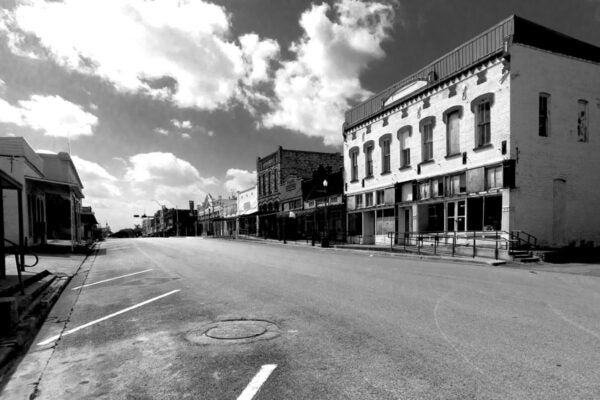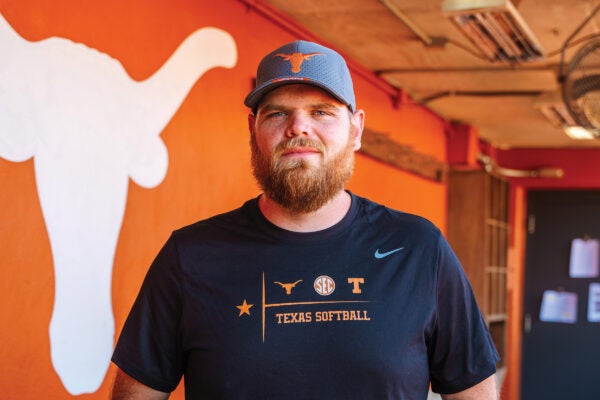Throughout the world, the story is the same — young people leaving their rural homes and small towns for cities. In China, the percentage of people living in cities has grown from 17 to nearly 60 since 1978. In the United States, the process of urbanization has been more gradual but has led to an even more extreme tilt because it has been underway much longer. Some 82% of Americans live in urban areas. But there are signs of acceleration; in just more than 20 years, more than 700 rural counties have lost at least 10% of their populations.
Even as Texas lives in the national imagination as a wide-open range, its urbanization reflects national trends. Just 18% of Texans live outside of metropolitan areas, and six of America’s 25 largest cities are here: Houston (4), San Antonio (7), Dallas (9), Austin (11), Fort Worth (15) and El Paso (22).
So, is an ever-more-urban Texas anything to fret over? Why not let small towns dry up and go extinct, Darwin-style, and surrender what’s left to agribusiness giants to manage from remote corporate headquarters?
There are a host of reasons that small towns and rural life will continue to exist and should, says psychology professor Art Markman. Family support systems might be greater there. A small town might work better for someone at a given stage of life. And keeping rural life desirable will help keep cities from becoming unbearably congested, to list just a few.
But there are economic disparities. Texas has 191 counties classified by the U.S. Census Bureau as majority-rural, and their per capita income is about $3,000 lower than that of nonrural counties. Creating more economic opportunities would help the entire state, so fostering economic growth in Texas outside of big cities is the new mission of The University of Texas at Austin’s IC2 Institute, where Markman — one of the university’s most audible public intellectuals as co-host of KUT’s “Two Guys on Your Head” podcast — now serves as executive director.
With economic disparities come a multitude of chicken-and-egg problems. Small towns and rural areas lack the critical mass to support top-tier health care. UT senior Janelle Chavez grew up in Port Isabel, where she saw her four grandparents struggle with broken bones, heart disease and cancer. Those experiences inspired her to work toward a medical degree. In her native Cameron County, the death rate from cervical cancer is significantly higher than elsewhere in Texas. Chavez wants to find ways to expand the state’s health care system in this low-income area at the tip of Texas and plans to return to the Rio Grande Valley to do medical research.
Emmalie Berkovsky grew up near Shiner and is studying to be a doctor at UT’s Dell Medical School. “Shiner, because it’s so rural, is medically underserved. It’s 50 miles to the closest large health center.” Surgery or a complicated illness requires a trip to Austin, San Antonio or Houston.
Another major issue for rural areas is connectivity. In an echo of early 20th century efforts to get electricity to rural areas, more than 30% of rural Americans still lack broadband internet access at home. While this gap might be inconvenient for rural residents wanting to post on social media or shop online, the real issues of broadband access fall into three major areas, according to Greg Pogue, deputy director of the IC2 Institute:
1) Access to data and educational opportunities.
2) Data quality and predictability for technology companies, due to the fact that even businesses as traditional as agriculture are rapidly becoming technology companies driven by data.
3) Jobs of the future that enable companies to use technology, big data, artificial intelligence and robotics to be profitable and scalable such that those companies stay in rural regions.
What’s more, the trend of urbanization has sociological limits. Some 236 of Texas’ 254 counties have fewer than 100,000 households. “Not everybody wants to live in an urban area or feels comfortable living in an urban area,” says Markman. “There are differences in values. There are differences in lifestyle. The smaller towns are not going to go away, and so what are the economic opportunities for people to live a life in which they could contribute to the world?”
If UT’s mission was just lifting up rural areas, that would be a noble goal. But looking at this enormous state in an urban/rural binary way oversimplifies the picture. About 70% of Texans are concentrated within the “Texas Triangle” that connects the DFW Metroplex, Houston and San Antonio. The Texas Triangle is considered one of 11 megaregions in America. And if 70% of Texans live inside the triangle, then more than 8 million do not, including those in Abilene, Amarillo, Corpus Christi, El Paso, Laredo, Longview, Lubbock, Midland-Odessa, the Rio Grande Valley, San Angelo, Tyler and Wichita Falls.
“When you think about the Amarillos; the Lexington, Kentuckys; the Fargo, North Dakotas, of the world — these are by definition cities, but they’re isolated cities,” says Markman. “They’re not part of a contiguous metro complex, and so the things that are required to enhance economic development in those regions have much more affinity with what rural areas have to do than what a place like Austin or Portland or Silicon Valley or Boston have to do to maintain their communities.”
There are rural areas within and along the Texas Triangle that have relatively easy access to city offerings; conversely, there are good-sized metro areas hundreds of miles outside that triangle that don’t benefit from its synergies. These isolated midsize metros are very much within IC2’s new focus.
WE WANT STUDENTS TO BEGIN LOOKING AT THEIR HOME COMMUNITIES WITH ADULT EYES.
The IC2 Institute (which stands for innovation, creativity and capital) has been associated with technology commercialization for more than 40 years. While that was a “large unstructured problem” that needed solving, it now is basically solved. For Markman and his colleagues, economic growth in rural areas is the new large unstructured problem worthy of the institute’s full attention.
The first thing the institute did was put out a call for research proposals, and the response from faculty members has been tremendous. During the next two years, the institute will support eight to 10 two-year research projects exploring this topic, and it is reaching out to foundations, other groups and donors that may want to fund long-term research in this area.
But IC2 bills itself not just as a think tank but as a “think and do” tank, and the first to-do they call “Home to Texas.” The institute has partnered with UT’s School of Undergraduate Studies to provide paid internships to first- and second-year UT students from rural areas and small cities to work in their home communities during the summer.
“These opportunities should be attractive to students from all disciplines. The School of Undergraduate Studies was a good fit for the program because of our first-year programs such as the Signature Courses and First-Year Interest Groups that reach so many students in all different majors across campus,” says Brent Iverson, dean of the school.
While home, students will learn about their communities from government officials, local business people and faith leaders. The aim is to get students to consider returning home after graduation to contribute to the economy in the region they came from. UT wants to place 20 students in internships this year. The Texas Exes, UT’s alumni association, has been reaching out through its chapters across the state, helping to identify companies interested in having a student for the summer.
“If you think about it, small towns have formed the identity of our great state,” says Chuck Harris, executive director of the Texas Exes. “A spirit of community and fellowship is interwoven with their history. In my role at the Exes, I get to spend a lot of time with our more than 130 chapters. In many ways, I’m envious of their lifestyle. It’s exciting to partner with the university to bring innovative, passionate and hard-working young people back home to the places that shaped them.”
“We want students to begin looking at their home communities with adult eyes,” says Markman. “You leave town at 17 or 18 years old, and all a student wants to do — again, life tasks — is get the heck out. We want them to come home for the summer, look at their town, understand what it means to be an adult in that community. We want them to meet with, interview, talk with civic leaders, government leaders and faith leaders and have them really say, ‘This is why people live here. These are the problems my community faces, but these are the benefits. This is why people call this place home.’”
Says Iverson: “I am hoping that in this first year we are able to establish a number of successful internships in all of the target hometowns. With that successful foundation, the popularity and scope of the program in each community would naturally grow. A more medium-term success for me would be a healthy number of returning students as well as returning employers in future years, indicating the program is effective and sustainable moving forward.”
Success isn’t necessarily that the student chooses to graduate and immediately go home, says Markman. The best opportunity for their first job might be in a metro area. The first thing they might have to do is go to graduate school. Rather, the goal is that, “at a point in their lives when they do have more discretion about where they might live, they think about moving back and being part of that community, and they recognize the contribution they could make to the economy in the place where they grew up,” Markman says.
If this initial program succeeds, UT could expand it to 200 students a year. At that point, the program would move beyond students from those places to introducing students from other places, including cities, to the opportunities that exist in outlying areas. Alumni might host students in their homes for a summer much as they would foreign students.
“There are lots of benefits to doing this that go above and beyond narrowly making sure that some of our students go home,” says Markman. “Even students who don’t go back to those communities will understand those communities better in ways that can have benefits and as they traverse their lives, consider causes they want to support, and ways they might want to vote.
“We are The University of Texas, not The University of Austin,” says Markman. “These issues matter to Texas.”




